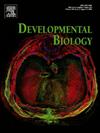Fluid secretion and luminal pressure control lateral branching morphogenesis in the embryonic avian lung
IF 2.5
3区 生物学
Q2 DEVELOPMENTAL BIOLOGY
引用次数: 0
Abstract
During lung development, the embryonic airway originates as a wishbone-shaped epithelial tube, which undergoes a series of branching events to build the bronchial tree. This process depends crucially on cell proliferation and is thought to involve distinct branching modes: lateral branching, wherein daughter branches emerge along the length of a parent branch, and bifurcations, wherein the tip of a parent branch splits to form two new daughter branches. The developing airway is fluid-filled, and previous studies have shown that altered luminal pressure can influence rates of branching morphogenesis. However, it is not clear if altered tissue mechanics influence patterns of proliferation along the embryonic airway epithelium nor if individual branching modes are affected differently by changes in luminal pressure. Here, we focused on mechanisms of lateral branching and used as a model system the embryonic avian lung, which forms exclusively via this branching mode during early development. We used microinjected fluid droplets or pharmacological modulators of fluid secretion to alter luminal fluid pressure either locally or globally within cultured embryonic lungs. Somewhat surprisingly, we found both local and global increases in luminal pressure to suppress the formation of new lateral branches while also promoting increased epithelial proliferation. In a consistent manner, decreased luminal pressure led to an increase in lateral branching morphogenesis. Morphometric analysis of airway branching patterns revealed that altered luminal pressure shifts the overall branching program, rather than simply changing rates of morphogenesis. Taken together, these results highlight the importance of mechanical forces during airway branching and suggest that different branching modes may be affected differently by luminal fluid pressure.

液体分泌和腔压控制胚胎禽肺侧分支形态发生。
在肺发育过程中,胚胎气道起源于一个叉骨状上皮管,它经历了一系列分支事件来构建支气管树。这一过程主要依赖于细胞增殖,并被认为涉及不同的分支模式:横向分支,子分支沿着父分支的长度出现;分支,父分支的尖端分裂形成两个新的子分支。发育中的气道充满液体,以前的研究表明,改变腔压可以影响分支形态发生的速度。然而,目前尚不清楚改变的组织力学是否会影响沿胚胎气道上皮的增殖模式,也不清楚单个分支模式是否会受到腔压变化的不同影响。在这里,我们重点研究了侧分支的机制,并将禽类胚胎肺作为模型系统,在早期发育过程中,禽类胚胎肺完全通过这种分支模式形成。我们使用微注射液滴或液体分泌的药理学调节剂来改变局部或整体培养的胚胎肺内的腔液压力。令人惊讶的是,我们发现局部和整体管腔压力的增加抑制了新侧枝的形成,同时也促进了上皮细胞的增殖。与此一致的是,管腔压降低导致侧分支形态发生增加。气道分支模式的形态计量学分析表明,管腔压的改变改变了整个分支程序,而不仅仅是改变了形态发生的速率。综上所述,这些结果突出了机械力在气道分支过程中的重要性,并表明不同的分支模式可能受到腔内流体压力的不同影响。
本文章由计算机程序翻译,如有差异,请以英文原文为准。
求助全文
约1分钟内获得全文
求助全文
来源期刊

Developmental biology
生物-发育生物学
CiteScore
5.30
自引率
3.70%
发文量
182
审稿时长
1.5 months
期刊介绍:
Developmental Biology (DB) publishes original research on mechanisms of development, differentiation, and growth in animals and plants at the molecular, cellular, genetic and evolutionary levels. Areas of particular emphasis include transcriptional control mechanisms, embryonic patterning, cell-cell interactions, growth factors and signal transduction, and regulatory hierarchies in developing plants and animals.
 求助内容:
求助内容: 应助结果提醒方式:
应助结果提醒方式:


